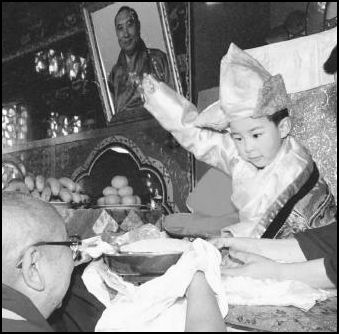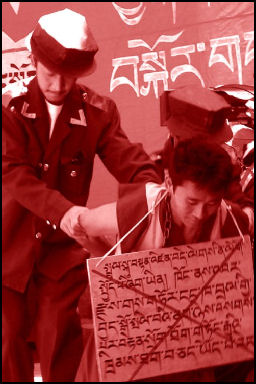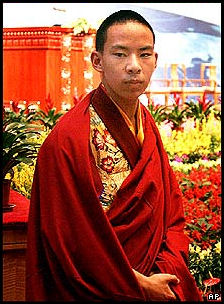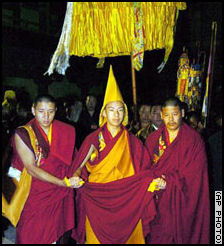SELECTION OF THE 11TH PANCHEN LAMA IN THE 1990s

The same year the tenth Panchen Lama died the Chinese government authorized a search committee to look for the soul boy who inherited his spirit and was his successor, the 11th Panchen Lama. At the same time a battle broke out between the Dalai Lama and the Communist government over who had the right to recognize the new Panchen Lama.
After the death of the tenth Panchen Lama a group of senior monks made several trips to Lhamo Latso, a sacred lake where important clerics go for spiritual guidance. After a period of time 28 boys were selected. One of them reportedly recited a mantra while in his mother's womb (which she heard) and told his mother from inside the womb on the day he was born, "I'm going to be born today."
In 1995, the head of the committee, the Chatral Rinpoche, sent a list of the boys to the Dalai Lama. On May 14, 1995, Dalai Lama made an announcement that a boy had been found in a remote area of central Tibet. The Dalai Lama told the New Yorker, "I made the divination, immediately. It pointed to one boy; a boy of six. When I looked at that boy's picture, I felt warm feelings, which developed the more I looked at it. Then, yesterday, I made another divination, and the name of the boy came."
See Separate Articles: PANCHEN LAMA: HISTORY, STATUS AND THE 10TH ONE factsanddetails.com; KARMAPA LAMA factsanddetails.com; DALAI LAMAS, THEIR HISTORY AND CHOOSING NEW ONES factsanddetails.com; PRESENT DALAI LAMA: EARLY LIFE, FAMILY AND TRAINING factsanddetails.com; Factsanddetails.com/China ; HISTORY OF TIBETAN BUDDHISM Factsanddetails.com/China ; TIBETAN BUDDHISM SECTS Factsanddetails.com/China
RECOMMENDED BOOKS: Panchen Lama “The Search for the Panchen Lama” by Isabel Hilton Amazon.com; “The Easy Path: Illuminating the First Panchen Lama's Secret Instructions” by Gyumed Khensur Lobsang Jampa and Lorne Ladner Amazon.com; “Prince of Shambala: A Biography of the Tenth Panchen Lama” by Tsangtruk Topla and Phurbu Doma Amazon.com; “A Poisoned Arrow: the Secret Report of the 10th Panchen Lama” By Bskal-Bzan-Tshe-Brtan Amazon.com
Dalai Lama's Panchen Lama
The boy selected by the Dalai Lama,Gedhun Choekyi Nyima was a born in the Tibetan village of Nagqu in 1989 four months after the Panchen Lama died. The divination used to select him involved placing the names of candidates on balls of tsampa (barley meal) in a bowl and rotating the bowl until one of the balls "jumps out."
The Dalai Lama said that Gedhun Choekyi Nyima had originally not ranked high on the list of boys but he left a great impression among the Lama selection committee. "This boy showed no excitement or fear. He greeted the lama as though he were an old friend. And when the lama asked him where he came from the child replied, 'I come from Tashilhunpo.' When the monk had to leave, the boy asked to go with him.'" Lamas also found special signs on his body.
Gedhun Choekyi Nyima and his family have not been seen in public since 1995. In 1996 Beijing acknowledged that they had detained him. He and his family are believed to be under house arrest.
Gedhun Choekyi Nyima, turned 22 in 2011. Most Tibetans as far as can be ascertained are still loyal to his memory,even if he has been missing since Chinese authorities swept him and his family into “protective custody” in 1995. “We just hope he is still alive,” Woeser, a Tibetan essayist and blogger, told the New York Times. She noted that Gedhun Choekyi Nyima’s visage, frozen as a 5-year-old, hangs in many homes and temples. “We are waiting for him.” [Source: Andrew Jacobs, New York Times August 6, 2011]
China's Rejection of the Dalai Lama's Panchen Lama

Dalai Lama's Panchen Lama
Chinese officials initially endorsed the selection but angrily withdrew their endorsement when they found out that selection committee had secretly sought out the advise of the Dalai Lama. The controversy marked the first time since the 18th century there have been rival claimants for the Panchen Lama.
Beijing took over Tashilhunpo Monastery, beat up some protesting monks and then launched a smear campaign against the Dalai Lama's choice. The 6-year-old Choekyi Nyima was accused of "once drowning a dog" and was said to be "notorious among their neighborhoods for speculation, deceit and scrambling for fame and profit." He called a traitor. After being placed under house arrest he was arguably the world's youngest political prisoner.
The 40 lamas that selected the boy were also detained." In 1997, Chadrel Rinpoche, a high-ranking lama and abbot of Tashilhunpo was sentenced to six years in prison for "splitting the country" and leaking state secrets (leaking information on Beijing's choice for the Panchen Lama). Chadrel Rinpoche had previously been accused of being a Beijing puppet. In 1994 he received an award for turning Tashilhunpo monastery into a "Resplendent Model of Safeguarding the Motherland by Displaying the Spirit of Patriotism."
China Chooses Its Panchen Lama
In 1995, after "declaring themselves the arbiters of Tibetan custom," the Chinese government chose another committee to select the Panchen Lama which the government said would not be influenced by "outside interference" — i.e. the Dalai Lama. In the past the Chinese emperor was sometimes asked to approve a new Dalai Lama or Panchen Lama after the selection had already taken place but the Communist twisted this custom around saying it gave them the right to oversee the choosing of the Dalai Lama through the selection of an ivory lot from a golden urn.
In a solemn ceremony in Lhasa's Jokhang Palace overseen by the Communists the names of three candidates (not including the one endorsed by the Dalai Lama) were placed on ivory lots and these were placed in the golden urn. The urn was shaken and a name was pulled out by a pro-Beijing lama.
Six-year-old Gyaincain Norbu was chosen. The son of a yak herder and member of the Communist Party, the boy was dressed in golden robes and a yellow silk hat. He then placed a yellow scarf around the neck of a Communist official who told the boy to "Love the country and study hard." The boy’s father said Gyaincain Norbu was attracted to Buddhist images at a young age. Pro-Beijing newspapers reported his birth had been accompanied by "beams of happiness," "incarnation of gods," and a peacock who was carried in on mysterious winds.
Seth Faison wrote in the New York Times: "It was if, after the College of Cardinals chose a Pope, then the Italian Prime Minister announced that he would not accept their candidate but would install his own. The Dalai Lama said,"The very fact that the Chinese are trying to select is totally senseless. Can you imagine some sacred Hindu tradition being performed by a Communist who does not even believe in religion.” How can it be possible." Before the ceremony the Dalai Lama issued a statement that said recognition of the reincarnation "is a religious matter and not political. It is my hope that the Chinese government...will extend its understanding, cooperation and assistance.”
The Panchen Lama chosen by Communist Party officials in 1995, named Gyaltsen Norbu at birth, is often referred to by local residents as the “Chinese Panchen Lama.” One Tibetan told the New York Times in 2008, “We’re not sure if its true that the Panchen was appointed by the government but if it is true we cannot support him. We wouldn’t support a Dalai Lama appointed by the government either. These people should be chosen by monasteries.”
Asked later, if he had any regrets about what happed the Dalai Lama told The New Yorker, “No I conducted my own religious investigation as to whether I should make the announcement and it was positive.” But later he said, “I feel that I committed the crime here, and they took the punishment there.”
Beijing's Panchen Lama

mock execution of
Panchen Lama Beijing' choice, Gyaincain Norbu, was installed in the Tashihunpo Monastery in Shigatse, surrounded by pro-Beijing monks and security guards. Not long afterwards he was flown to Beijing and was shown exchanging scarves with President Jiang Zemin. He now lives in heavily guarded compound, built for the tenth Panchen Lama, on the outskirts of Beijing, where the Communists have overseen his education. He and his education is under the supervision of a pro-Beijing religious teacher.
Gyaincain Norbu visits to Tibet have been few and far between. In July 1999, at the age of 9, he made a tour of Tibet. He was accompanied by armed guards and monks with walkie-talkies. One pro-Beijing lama described the visits as "a forceful counterattack to the...Dalai Lama clique."
When he was 12 Gyaincain Norbu made a special visit to Tashilhunpo monastery. He was delivered there in a 21-car motorcade, whisked past reporters stayed less than an hour and was taken away by the motorcade without hardly exchanging words with anybody.
In October 2005,the Gyaincain Norbu visited Shigatse again. State television showed him wavings to cheering crowds and meeting with more than 600 monks at Tashilhunpo monastery. In December he appeared on the state-run media, praising China’s policies. “I’ve been to many places in the past decade and witnessed the ample freedom enjoyed by individuals and religious organizations alike. Living Buddha’s like myself are able to perform religious rituals under the wing of the Chinese Constitution and other laws.” He also said the Communist party has brought “wealth harmony and stability” to Tibet.
In April 2006, Gyaincain Norbu, the Chinese-appointed 11th Panchen Lama, showed up at an international Buddhist conference in Hangzhou. He appeared on stage at the opening of the event and gave a 10 minute speech in which he said that it was the responsibility of Buddhism to nurture patriotism and national unity. He also said “defending the nation and working for the people is the solemn commitment Buddhism has made to the nation and society.” At the same event the Dali Lama was accused of being a ‘saboteur of ethnic unity and a purser of splitism.”
In February 2008, the Beijing-designated Panchen Lama made a rare appearance, He was shown giving a long piece of silk as a gift to Wu Bangguo, the chairman of the Standing Committee of the National People’s Congress. Chinese news sources said the Panchen Lama ‘supported” the Communist Party and made “contribution to the Tibetan economy and social harmony by aiding more religious work to adapt to China’s socialist society.” The same month the Panchen Lama was named as China’s youngest Cabinet-level official. There was also some talk of making him a member of the Standing Committee of the Communist Party.
In March 2010, the Panchen Lama was named as member of China’s top legislative advisory body — the 2,200 member National Committee of the Chinese People’s Political Consultative Conference.
Attempts to Legitimize the Chinese Panchen Lama

Beijing's Panchen Lama
Andrew Jacobs wrote in the New York Times: “As Gyaltsen Norbu moves from adolescence to adulthood, Chinese authorities are facing a quandary over how to burnish his bona fides: his standing will continue to suffer if he remains apart from Tibetan monks and the faithful, but officials risk inflaming passions by foisting him on a community that remains deeply suspicious.” [Source: Andrew Jacobs, New York Times August 6, 2011]
“The government has struggled to legitimize their Panchen Lama. In recent years, the Communist Party has tried other means to raise his profile. They named him vice president of the state-run Buddhist association and appointed him to the Chinese People’s Political Consultative Conference, an advisory body that meets annually in Beijing. “
“Despite what might seem like insurmountable obstacles to the Panchen Lama’s legitimacy, a number of experts said the government’s long-term strategy might give him at least some credibility. Even if they are unhappy with the arrangement, Tibetans understand the necessary bargain that their spiritual leaders must make with the authorities. Arjia Rinpoche, the exiled former abbot, said that if the Panchen Lama one day showed a hint of independence, Tibetans could come to respect him. “People say that even if he’s not a real reincarnation, at least he’s a real Tibetan, and maybe when he grows up he can believe in the Dalai Lama and do something good for Tibet,” he said.
Perceptions of the Chinese Panchen Lama
So far public statements by the Chinese Panchen Lama have left Tibetans unimpressed. In one typically stolid remark in March 2011, he said, “We live in a society governed by law, while the religious practices fall into the category of social activity; therefore, only by administration according to law can we ensure a stable and harmonious development of religious affairs.” [Source: Andrew Jacobs, New York Times August 6, 2011]
Images of the Chinese (11th) Panchen Lama are difficult to find. One shop worker in Lhasa told the Washington Post there isn’t any demand for images of the Chinese Panchen, while another man dismissed him as a “Chinese Buddhism official.” Images of the ninth and 10th Panchen Lamas easy to find. “Tsering Shakya, a Tibetan historian and scholar at the University of British Columbia, told the Washington Post that the fact that the Chinese Panchen Lama does not live in his traditional seat in Tibet’s Tashi Lhunpo Monastery shows that monks there still do not accept him. [Source: Simon Denyer, Washington Post, September 26, 2016]
The government bureaucrats who oversee Tibetan affairs have come to the conclusion, one rooted in history, that only a significant stint in a prominent monastery can bolster the Panchen Lama’s religious credentials, according to scholars and local religious figures. “The Tibetans respect good Buddhist practice and accomplishment,” Hu Shisheng, a researcher at the China Institute of Contemporary International Relations, told the New York Times,
Chinese Panchen Lama Studies at Labrang Monastery

Andrew Jacobs wrote in the New York Times: “In the summer of it was rumored the Chinese Panchen Lama was going to study at Labrang Monastery Xiahe, starkly beautiful town in the mountains of Gansu Province. Monks and researchers have said that Labrang was most likely selected because the region's most senior religious figure has been especially cooperative with Beijing. Another factor may be that one of the tutors who teaches the Panchen Lama at his home in Beijing hails from Labrang. But his presence is not universally welcomed by the faithful there.”Nobody wants him to come, and yet still he will come,” said one 26-year-old monk. “We feel powerless.”
“A previous attempt to improve the Panchen Lama’s religious standing in 1998 did not end well. After officials sought to pair the boy with the abbot of Kumbum, a revered monastery in Qinghai Province, the abbot, Arjia Rinpoche, fled China and sought asylum in the United States. “It was a very difficult decision, but I did not want to be seen as a collaborator with the Chinese government,” Arjia Rinpoche said by telephone from Indiana, where he now lives. “
According to several Tibetans, both in China and abroad, the antipathy has been strong enough that the authorities may have already scaled back their plans to have the Panchen Lama spend months studying at Labrang Monastery, one of the most important centers of Buddhist learning “and the scene of recent protests against Chinese rule that were prompted by much deadlier ethnic rioting in Lhasa. One Qinghai-based scholar who said that he had spoken to senior lamas at Labrang in recent days noted that many rank-and-file monks had expressed concern that the Panchen Lama would bring with him security agents, surveillance cameras and even more restrictions than those that already govern the lives of the monastery’s more than 1,000 monks. “There is no historical precedent for installing a Panchen Lama at Labrang,” said the scholar, who asked for anonymity to shield himself from potential trouble. “But more importantly, they worry Labrang will become like a circus, not a monastery.”
Labrang monastery includes a coterie of fiercely independent monks who could make things uncomfortable for the Panchen Lama. A few months after violent protests that jolted the Tibetan plateau in 2008, 15 monks rushed out of the monastery waving the banned Tibetan flag during a government-arranged visit for foreign journalists. “We have no human rights now,” they told reporters before older monks dispersed them. (Three of them later escaped to India to avoid punishment.) Another senior monk was later jailed for six months after posting a video online that described his torture during a previous detention.
More immediately, however, the prospect of a visit to Xiahe is causing consternation, and not only among the monks. Several government workers who are ethnic Tibetans have in recent days said they were threatened with wage cuts or dismissal if they did not greet the Panchen Lama with open arms.
Before he was interrupted by a Han Chinese business owner, one middle-age monk who spoke to a foreign visitor acknowledged the widespread discontent but said he was resigned to the Panchen Lama’s arrival. “I will not allow it to impact me,” he said. “I will continue to pray and be fully observant.”
Glimpses of the Life of the Dalai Lama’s Panchen Lama
Michael Bristow of the BBC wrote; Down the years, the Chinese government has provided some information about the missing Panchen Lama, even if it was just to deny anything was wrong. Immediately after his disappearance, it told the UN working group that "there has never been a case of disappearance and kidnapping of the family of the reincarnated child". It said the claim was a fabrication dreamt up by the "Dalai Lama group". The following year, 1996, the story changed. China said a few "unscrupulous souls" had tried to smuggle the boy abroad and so his parents had asked for protection, which it was supplying. [Source: Michael Bristow, BBC News, May 17, 2020]
“Despite the security, Beijing said the boy and his family were living normal lives and did not want anyone to bother them, something it has repeated often since then. Occasionally, the Chinese government offered a glimpse that not all was well. In 1998, it told the working group that the Panchen Lama's mother was serving a prison sentence, although it is not clear what for or how long she was incarcerated.
“At times there have been other sources of news. In 2000, Robin Cook, then the British foreign secretary, said China had shown UK officials two photographs of a boy it said was the missing Panchen Lama. One showed a child playing table tennis; in the other the boy was writing Chinese characters on a blackboard. The British were allowed to see the pictures, but not keep them. In another encounter, Tibetan officials told me, on a reporting trip to Tibet in 2007, that the missing Panchen Lama would like to live in peace and does not want to be disturbed.
“The last firm news.” before 2020,,” according to the Tibetan government-in-exile, based in Dharamsala in India, came in 2018 when China told the UN that the Panchen Lama was living an ordinary life and had a job. Professor Jeremy Sarkin, who served on the UN working group from 2008-20014, said China had clearly disappeared the Panchen Lama in contravention of UN human rights rules. "The words the Chinese use do not refute reality. They took him and his family," he said. "We should be allowed to check he is safe." The fact that China shies away from openly admitting what it has done is not unusual, said the professor, now at the Nova University of Lisbon. "No state wants to acknowledge they disappear people." But Mr Sarkin said there was little anyone could do about the disappearance - and little pressure to try.
Dalai Lama’s Panchen Lama Pick: College Graduate with a Job in 2020

Beijing's Panchen Lama In May 2020, China said that a boy who disappeared 25 years earlier after being picked by the Dalai Lama to be the Panchen Lama was a 31-year-old college graduate with a stable job. Associated Press reported: “Very little information has been given about Gedhun Choekyi Nyima or his family since he went missing at age 6 shortly after being named the 11th Panchen Lama.” China’s choice, Gyaltsen Norbu, is rarely seen and is believed to spend most of his time in Beijing. He is generally viewed as a political figure under Beijing's control and shares none of the Dalai Lama's global fame. [Source: Associated Press, May 19, 2020]
“Foreign ministry spokesperson Zhao Lijian said Gedhun Choekyi Nyima “received free compulsory education when he was a child, passed the college entrance examination and now has a job." Zhao said neither the man or his family wishes to be disturbed in their “current normal lives.” No other details were given.
Tibetans outside China have called for his release. But only Chinese officials know where he is “China’s abduction of the Panchen Lama and forcible denial of his religious identity and right to practice in his monastery is not only a violation of religious freedom but also a gross violation of human rights,” the Tibetan parliament in northern India, known as the Kashag, said in a statement. The UN Working Group on Enforced or Involuntary Disappearances has been trying to find out what has happened to Gedhun Choekyi Niyima since 1995, but it has had little success. The group told the BBC: “"The Government of China has responded several times, but the information provided was considered insufficient to clarify the case and it remains outstanding."
Image Sources: Purdue University, Wikipedia, xinhua, encyclopedia.com
Text Sources: New York Times, Washington Post, Los Angeles Times, Times of London, National Geographic, The New Yorker, Time, Newsweek, Reuters, AP, Lonely Planet Guides, Compton’s Encyclopedia and various books and other publications.
Last updated September 2022
